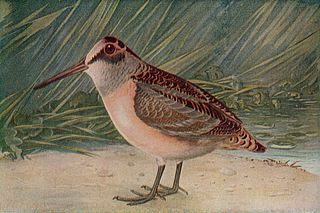Dusky woodcock has been split into two species:
- Javan woodcock, Scolopax saturata
- New Guinea woodcock, Scolopax rosenbergii
Dusky woodcock has been split into two species:

The woodcocks are a group of seven or eight very similar living species of wading birds in the genus Scolopax. The genus name is Latin for a snipe or woodcock, and until around 1800 was used to refer to a variety of waders. The English name was first recorded in about 1050. According to the Harleian Miscellany, a group of them is called a "fall."

The American woodcock, sometimes colloquially referred to as the timberdoodle, the bogsucker, the hokumpoke, and the Labrador twister, is a small shorebird species found primarily in the eastern half of North America. Woodcocks spend most of their time on the ground in brushy, young-forest habitats, where the birds' brown, black, and gray plumage provides excellent camouflage.

The Eurasian woodcock is a medium-small wading bird found in temperate and subarctic Eurasia. It has cryptic camouflage to suit its woodland habitat, with reddish-brown upperparts and buff-coloured underparts. Its eyes are set far back on its head to give it 360-degree vision and it probes in the ground for food with its long, sensitive bill, making it vulnerable to cold weather when the ground remains frozen.

The Amami woodcock is a medium-sized wader. It is slightly larger and longer-legged than Eurasian woodcock, and may be conspecific.
The Sulawesi woodcock also known as Celebes woodcock, is a medium-sized wader. It is larger and darker than Eurasian woodcock but with small reddish spots.

The Moluccan woodcock, also known as Obi woodcock, is a medium-sized, approximately 40 cm long, forest wader with long and dark bill, orange buff below and black barred upperparts. The plumage is marked with large buff spots. This species is the largest of the woodcocks, 25% bigger than Eurasian woodcock.

The great snipe is a small stocky wader in the genus Gallinago. This bird's breeding habitat is marshes and wet meadows with short vegetation in north-eastern Europe, including north-western Russia. Great snipes are migratory, wintering in Africa. The European breeding population is in steep decline.

Gallinago is a genus of birds in the wader family Scolopacidae, containing 17 species.
The Bukidnon woodcock, or Philippine woodcock is a medium-sized wader. It was only described as new to science as recently as 2001, although the initial specimens had been collected on Luzon in the 1960s, these were originally misidentified as Eurasian woodcock specimens. It was not until the bird was heard calling in 1993, and new specimens obtained on Mindanao in 1995, that it was realised that the species was new. It is listed as Least Concern by the IUCN.
A Woodcock is one of seven very similar wading bird species in the genus Scolopax.

Longleat Woods is a 249.9 hectare biological Site of Special Scientific Interest south of Frome in Somerset, notified in 1972.
Nankivell is a surname originating from Cornwall. Notable people with the surname include:

Murex scolopax, also known as the False venus comb or Woodcock murex, is a species of large predatory sea snail, a marine gastropod mollusk in the family Muricidae, the rock snails or murex snails.

Ophrys scolopax, known as the woodcock bee-orchid or woodcock orchid, is a species of terrestrial orchid found around the Mediterranean and the Middle East, from Morocco and Portugal to Hungary and Iran.
The New Guinea woodcock is a species of bird in the family Scolopacidae formerly considered to be conspecific with the Javan woodcock and called collectively the dusky woodcock. It is endemic to New Guinea and is found in both the Indonesian and Papuan parts of the island.

The Javan woodcock or rufous woodcock is a small wader. It is smaller than Eurasian woodcock, and has much darker plumage. It was formerly considered to be conspecific with the New Guinea woodcock and called collectively the dusky woodcock.

The Pennsylvania State Game Lands Number 48 are Pennsylvania State Game Lands in Bedford County in Pennsylvania in the United States providing hunting, bird watching, and other activities.
Scolopax brachycarpa, is an extinct species of woodcock in the family Scolopacidae that was endemic to the Caribbean island of Hispaniola.
Scolopax anthonyi is a prehistoric species of woodcock in the family Scolopacidae that was once endemic to the Caribbean island of Puerto Rico. Fossil remains were initially identified as belonging to a snipe of the genus Gallinago, but a re-analysis of the bones in 1976 indicated that they belonged to a woodcock. It has more osteological similarities to Eurasian woodcock than the American woodcock, a trait it shares with the extinct Scolopax brachycarpa of Hispaniola. Both of these species may have belonged to a distinct insular radiation in the Caribbean, which are now extinct.
Gallinago kakuki is a prehistoric species of snipe in the family Scolopacidae that was once endemic to the West Indies. Fossils of this species are known from the Bahamas, Cuba, and Cayman Brac in the Cayman Islands.